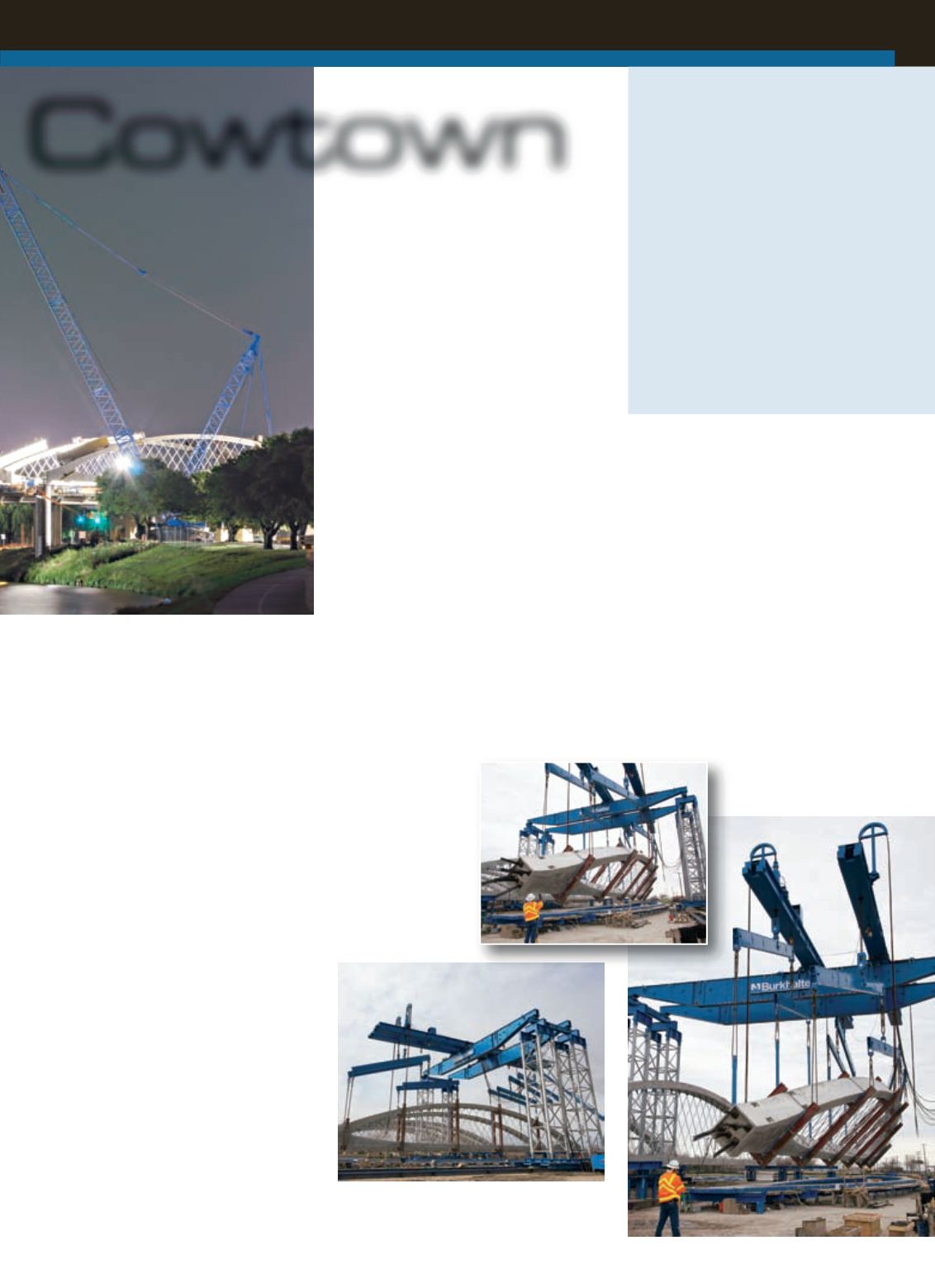
43
LIFTING
SITE REPORT
AUGUST 2013
ACT
Cowtown
a year ago. The first year of bridge
construction caused little to no impact
on motorists and businesses. The arches
were constructed at a nearby casting yard
donated by Chesapeake Energy.
Each arch is 163.5 feet long and weighs
300 tons. Within the arch, there is a
network of stainless steel hangers with
clevises and tie-beam connections that
protect pedestrians from traffic on the
bridge while allowing both motorists and
pedestrians to enjoy a nearly unobstructed
view of the river.
This new construction method is
expected to result in seven fewer months
of bridge closure compared to a typical
12 months or more using traditional
methods, TXDOT says.
Key to the construction of the West 7th
Street Bridge was the innovative rigging
plan and performance of crews from
Columbus, MS-based Burkhalter Rigging.
Burkhalter Rigging crews were
responsible for the lift, rotation and
storage of the arches as they were cast, as
well as the transportation of the arches to
the bridge site and then lifting and setting
of the arches into place, according to
Delynn Burkhalter, president.
The arches were constructed on a site
about a mile away from the actual bridge.
The concrete arches were cast in groups
of two.
Fast facts
COST:
$25.9 million
LENGTH:
982 feet
WIDTH:
88 feet
SCHEDULE:
Off-site construction started in
January 2012. The old bridge was closed
in May 2013 and the new bridge is set for
opening before Thanksgiving 2013.
GENERAL CONTRACTOR:
Sundt Construction
There are several videos of the construction,
transport, lifting and placement of the
arches on the bridge. For the best videos
visit the TXDOT You Tube page at: http://
roOVAAjTmlqCxvSVS-oJRBGZW.
After each set of two arches was cast,
Burkhalter used its “Mini-BSET,” a hybrid
tower gantry system, to lift, rotate and
slide each arch into a storage location on
the construction yard. Burkhalter started
work at the pre-cast and storage site in
August of 2012.
Set up over the area where the arches
were cast in place, the BSET carefully
lifted and rotated the arches to an upright
position. It took about 3.5 hours to lift and
rotate each arch upright and into position
for storage.
All of the arches were completed and
stored by February 2013. In May, the old
bridge was shut down to traffic. Once
the new bridge columns were in place,
Burkhalter crews began the transportation
of the arches over the decaying 100-year-
old existing bridge to the site and setting
them onto their supports.
Remote controlled SPMTs
“Each arch was transported from the
construction yard to the bridge site via
self-propelled mobile transporter,” says
Burkhalter.
Using remote controlled operation of
the SPMTs, crews slowly maneuvered
each arch into position. The arch was then
rigged so the cranes
could pick it up and
set it on its support
columns. Once
both cranes had
the weight of the
arch on its hooks,
the SPMTs were
driven out from
underneath it.
“They were lifted
Burkhalter’s Mini-BSET lifts and rotates
one of the concrete arches at the site
where they were precast.
off the SPMT, positioned and set onto
concrete columns using two Liebherr
LR1400 crawler cranes, each rigged with
superlift attachments,” Burkhalter says.
The setting of the arches, and
subsequent assembly/disassembly/
movement/reassembly of the cranes was
a continual process from May until mid-
June when the last arch was set in place.
Six arches were placed along each side of
the bridge.
The cranes had to be repositioned eight
times. The arches were mostly placed
in sets of two, with two arches set every
four or five days. Burkhalter had to work
around a variety of obstacles, including
road closures, poor ground conditions, a
multitude of utilities, and
tight contractor scheduling
windows.
■


